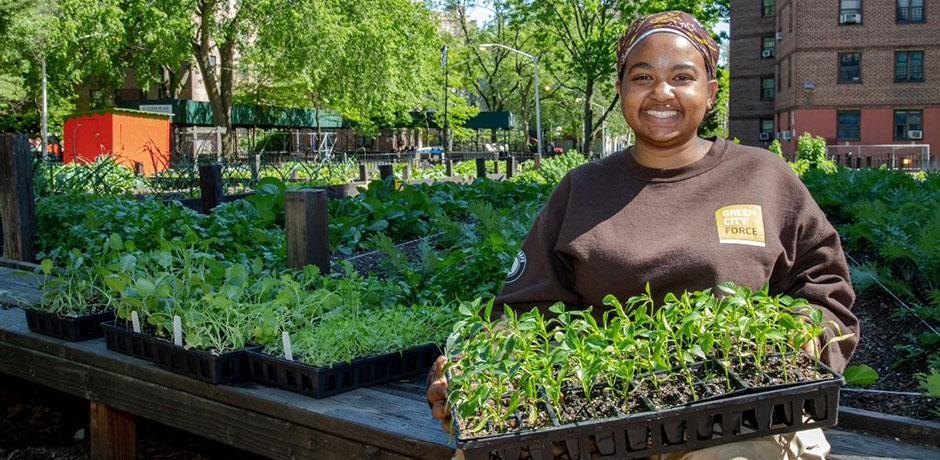The Ultimate Guide To City Blooming
The Ultimate Guide To City Blooming
Blog Article
Getting My City Blooming To Work
Table of ContentsSome Known Factual Statements About City Blooming Some Known Facts About City Blooming.See This Report about City Blooming9 Easy Facts About City Blooming Shown6 Simple Techniques For City Blooming
Intrigued in expanding food up for sale in the City of Chicago? Thinking concerning starting a community yard? Modifications to the Chicago Zoning Ordinance allow farming usages like neighborhood yards and metropolitan ranches in several components of the city. Below is a listing of frequently asked concerns relating to the regulations and regulations that growers need to take into consideration when intending a city farming job.
The zoning modification does not customize any kind of other codes handling composting, building licenses, buying or leasing City owned residential or commercial property, business licenses or ecological contamination. There are existing codes that manage these issues and they continue to be in complete effect and might be applicable to your project. Area gardens are typically possessed or handled by public entities, civic organizations or community-based companies and maintained by volunteers.
Urban farms grow food that is meant to be marketed, either on a not-for-profit or for-profit basis. Due to their industrial function, city farms need an organization license.
Some Of City Blooming
The amount of compost material can not exceed 25 cubic backyards at any kind of offered time according to the criteria in 7-28-715 of the City's Municipal Code. Since the soil at the majority of new yard sites needs modifying, compost, dirt, timber chips, or other materials can be acquired to build or boost the expanding space.

If a structure license is required then the hoophouse will certainly be taken into consideration an accessory structure. You can discover out more concerning the structure permit requirements by contacting the Department of Structures. The 25,000-square-foot dimension limitation is intended to protect against a solitary neighborhood yard from controling a provided block or detracting from the block's existing household or commercial personality.
The limitation does not put on yards found in Public Open Space (POS) areas. Can there be more than one area garden that is 25,000 square feet on a single block? Yes. The size restriction puts on private yards, not to private blocks. No. Fencing is not called for, nonetheless, yards that have large parking areas might be required to mount fencing or various other landscape design functions.
City Blooming Can Be Fun For Anyone
B1 & B2 areas call for that all commercial use tasks be performed inside. Is secure fencing required for metropolitan farms? Fencings might be called for, along with landscape design and screening, for specific car parking areas and outside work or storage locations depending on location and the specific task taking location.
Yes. Urban ranches require structure permits and zoning approvals prior to building. Various other kinds of city review might be needed relying on details frameworks, tasks, dimension, landscape design, licensing, public health and stormwater administration problems. A lot of these demands are recognized in the job style or allowing process, however, the applicant might be accountable to separately determine certain licenses or allows that may be needed.
The Department of Company Affairs and Consumer Defense can help determine the details type of service license that's required. Off street car parking is his response required for a lot of commercial projects in Chicago. The required number of parking rooms is based on the number of workers functioning on site and not the square video of the growing space.
The Best Strategy To Use For City Blooming

A city farm can sell compost material generated on site, nevertheless, the operation has to conform with the regulations in 7-28-715 of the Chicago Municipal Code. Aquaponic systems are enabled indoors on city ranches in lots of zoning areas.
Up to five hives or colonies of honey may be maintained as an accessory use. However, beekeepers should register with the Illinois Division of Agriculture. For additional information regarding the recommended zoning change you may contact the Division of Real Estate and Economic Advancement, Bureau of Planning and Zoning at 312.744.8563.
Farming in cities and metropolitan locations An urban ranch in Chicago. Urban farming describes different techniques of growing. http://peterjackson.mee.nu/where_i_work#c2252, processing, and dispersing food in metropolitan areas. The term likewise relates to the location activities of pet husbandry, tank farming, beekeeping, and gardening in an urban context. Urban agriculture is differentiated from peri-urban agriculture, which occurs in rural locations beside residential areas.
What Does City Blooming Mean?
, who look for to form social networks established on a common values of nature and community holism. These networks can create by method of official institutional assistance, ending up being integrated into neighborhood community planning as a "transition town" motion for sustainable urban growth.
Some of the first evidence of city farming comes from Mesopotamia.
Report this page